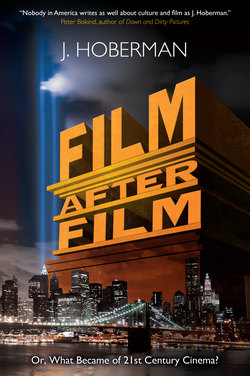Читать книгу Film After Film - J. Hoberman - Страница 5
На сайте Литреса книга снята с продажи.
ОглавлениеPREFACE
It may seem absurd, barely a decade into the millennium, to speak of a distinctly “twenty-first-century cinema.” Despite the universal predilection for organizing trends by decades, it’s obvious that cultural development is neither determined by a timetable nor bound to an arbitrary calendar. And yet, in the case of the cinema there are two—or even two and a half—reasons to consider the possibility that, since 2001, the nature and development of the motion picture medium has become irrevocably altered.
This new situation, which was accompanied by the oft-articulated perception that motion pictures, as they had existed in the century following the Lumière brothers’ first demonstration of their cinématographe, had entered a period of irreversible decline, arises from a technological shift in the basic motion picture apparatus—namely, the shift from the photographic to the digital that began tentatively in the 1980s, and gathered momentum from the mid ’90s onward. The digital turn occurred in the midst of and was amplified by pre-millennial jitters, not unlike the fantasy that the world’s computers would crash when the date shifted from December 31, 1999 to January 1, 2000. The second, more unexpected and less rational, reason for the new situation occurred barely nine months into the twenty-first century. This was a world-historical happening, namely the events of September 11, 2001. As watched by millions “live” and in heavy rotation on TV—which is to say, as a form of cinema—these events could not help but challenge, mystify, and provoke filmmakers as individuals while, at the same time, dramatizing their medium directly in an impersonal way. No less than Titanic or The Lord of the Rings trilogy or the saga of Harry Potter (and actually, a good deal more so), the events of 9/11 were a show of cinematic might.
This is not to say that twentieth-century cinema no longer exists—even nineteenth-century cinema is with us still. But the digital turn, accompanied by a free-floating anxiety regarding the change in cinema’s essential nature and a cataclysmic jolt out of the clear blue sky that, for the vast majority of the world’s population, was apprehended as a manmade cinematic event, have all combined—perhaps conspired—to create something new. That new thing is the subject of this book.
Film After Film is a direct outgrowth of my work as both a lecturer on cinema history and a professional journalist who reviewed (or reported on) current movies on a weekly basis. Like many twenty-first-century films which fuse the digital and the photographic, Film After Film is also something of a cyborg entity, combining analysis and reportage. The book is divided into three parts. The first, titled “A Post-Photographic Cinema” (Film After Film) and greatly expanded from an essay first published in Artforum, proposes the notion of twenty-first-century cinema and attempts to characterize, theorize and historicize it. Part II, “A Chronicle of the Bush Years” (Film After Film After Film … ), culls the 400 or so weekly reports and occasional cover stories I published in the Village Voice between September 2001 and November 2008 to revisit the early twenty-first century as it unfolded—or, put another way, to write the first draft of its film history.
The 750-word weekly film review is a specific journalistic form: over a period of months and years, these topical short pieces document a writer’s attempt to make sense of the ongoing flux of movies amid the ongoing flux of events. Thus, part II is a chronicle of the George W. Bush presidency, a reign defined not only by the events of 9/11 but by continuous foreign wars, the much-publicized threat of additional terror attacks, and further disasters—both natural and manmade—as viewed from a screening room. The movies discussed are nearly all American and, while not necessarily the strongest of the period (some of those may be found in other sections) are nevertheless the ones that seemed most directly responsive to or reflective of the post-9/11 climate. Chronologically arranged, these journalistic reports have been somewhat edited but never updated. Rather than rewrite them in light of subsequent events (which include the movies’ receptions), thus contaminating the spontaneity of an original impression, I have chosen to annotate and historically contextualize my original response in bold type.
As already noted, one impetus for Film After Film came from a series of university courses I taught on the nature of twenty-first-century cinema. This book is very much intended as a resource, if not a text, for similar courses. By way of an addendum (or an extended footnote to part I), part III, “Notes Toward a Syllabus” (Some Films After Film), offers twenty-one short essays on programs of work that I showed (or would have liked to have shown) in class. For a number of reasons—sometimes technical, at others thematic or aesthetic—these seem to me to be quintessentially twenty-first-century motion pictures. Reworked from class lectures and/or reviews—most of which were originally published in the Village Voice, though several versions of pieces first appeared elsewhere, including Artforum (Battle in Heaven, The World, and The Strange Case of Angelica), Film Comment (Russian Ark and Carlos, as well as the essay on Arnold Schwarzenegger), and Sight and Sound (Dogville)—these film notes focus on international production in a variety of cinematic modes (albeit work characterized by a certain historical self-consciousness).
Many, though not all, of the cinema-objects discussed here are available on DVD. In addition to providing practical suggestions for a survey of twenty-first-century cinema, this selection should serve to demonstrate that, hardly the arid desert some have imagined, the century’s first decade abounded with significant and radically innovative cinema.
J. Hoberman
New York, March 2012
